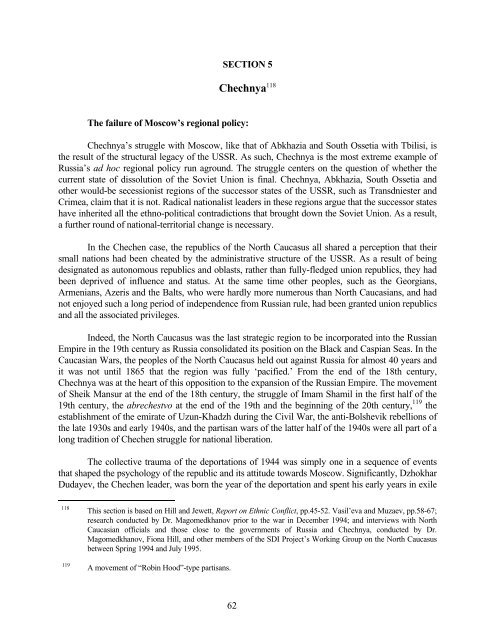RUSSIA'S TINDERBOX - Belfer Center for Science and International ...
RUSSIA'S TINDERBOX - Belfer Center for Science and International ...
RUSSIA'S TINDERBOX - Belfer Center for Science and International ...
Create successful ePaper yourself
Turn your PDF publications into a flip-book with our unique Google optimized e-Paper software.
SECTION 5<br />
Chechnya 118<br />
The failure of Moscow’s regional policy:<br />
Chechnya’s struggle with Moscow, like that of Abkhazia <strong>and</strong> South Ossetia with Tbilisi, is<br />
the result of the structural legacy of the USSR. As such, Chechnya is the most extreme example of<br />
Russia’s ad hoc regional policy run aground. The struggle centers on the question of whether the<br />
current state of dissolution of the Soviet Union is final. Chechnya, Abkhazia, South Ossetia <strong>and</strong><br />
other would-be secessionist regions of the successor states of the USSR, such as Transdniester <strong>and</strong><br />
Crimea, claim that it is not. Radical nationalist leaders in these regions argue that the successor states<br />
have inherited all the ethno-political contradictions that brought down the Soviet Union. As a result,<br />
a further round of national-territorial change is necessary.<br />
In the Chechen case, the republics of the North Caucasus all shared a perception that their<br />
small nations had been cheated by the administrative structure of the USSR. As a result of being<br />
designated as autonomous republics <strong>and</strong> oblasts, rather than fully-fledged union republics, they had<br />
been deprived of influence <strong>and</strong> status. At the same time other peoples, such as the Georgians,<br />
Armenians, Azeris <strong>and</strong> the Balts, who were hardly more numerous than North Caucasians, <strong>and</strong> had<br />
not enjoyed such a long period of independence from Russian rule, had been granted union republics<br />
<strong>and</strong> all the associated privileges.<br />
Indeed, the North Caucasus was the last strategic region to be incorporated into the Russian<br />
Empire in the 19th century as Russia consolidated its position on the Black <strong>and</strong> Caspian Seas. In the<br />
Caucasian Wars, the peoples of the North Caucasus held out against Russia <strong>for</strong> almost 40 years <strong>and</strong><br />
it was not until 1865 that the region was fully ‘pacified.’ From the end of the 18th century,<br />
Chechnya was at the heart of this opposition to the expansion of the Russian Empire. The movement<br />
of Sheik Mansur at the end of the 18th century, the struggle of Imam Shamil in the first half of the<br />
19th century, the abrechestvo at the end of the 19th <strong>and</strong> the beginning of the 20th century, 119 the<br />
establishment of the emirate of Uzun-Khadzh during the Civil War, the anti-Bolshevik rebellions of<br />
the late 1930s <strong>and</strong> early 1940s, <strong>and</strong> the partisan wars of the latter half of the 1940s were all part of a<br />
long tradition of Chechen struggle <strong>for</strong> national liberation.<br />
The collective trauma of the deportations of 1944 was simply one in a sequence of events<br />
that shaped the psychology of the republic <strong>and</strong> its attitude towards Moscow. Significantly, Dzhokhar<br />
Dudayev, the Chechen leader, was born the year of the deportation <strong>and</strong> spent his early years in exile<br />
118 This section is based on Hill <strong>and</strong> Jewett, Report on Ethnic Conflict, pp.45-52. Vasil’eva <strong>and</strong> Muzaev, pp.58-67;<br />
research conducted by Dr. Magomedkhanov prior to the war in December 1994; <strong>and</strong> interviews with North<br />
Caucasian officials <strong>and</strong> those close to the governments of Russia <strong>and</strong> Chechnya, conducted by Dr.<br />
Magomedkhanov, Fiona Hill, <strong>and</strong> other members of the SDI Project’s Working Group on the North Caucasus<br />
between Spring 1994 <strong>and</strong> July 1995.<br />
119 A movement of “Robin Hood”-type partisans.<br />
62
















